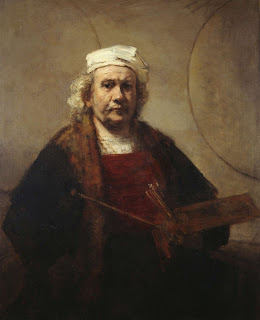Inspired by the fantastic exhibitions dedicated to portraiture that we have enjoyed this year so far, including Rembrandt: The Late Works at the National Gallery, Self at Turner Contemporary and the BP Portrait Award, an annual favourite that is currently on show at the National Portrait Gallery, here is our round-up of the much-loved portraits that London’s galleries have on offer:
‘Self-portrait with two circles’, Rembrandt Van Rijn, Kenwood House.
‘The Arnolfini Portrait', Jan Van Eyck, The National Gallery.
 |
‘Mr and Mrs Clark and Percy’, 1970- 1, © David Hockney
This painting forms part of a series of large double portraits which Hockney started in 1968. Working from both photographs and life, the sitters are depicted in their homes. Hockney described the painting as one of his most naturalistic works. Although it is in part realistic, the style is also simplified; there is minimal detail and the composition has been flattened.
Placed either side of a large open window, ‘Mr and Mrs Clark’ are the dress designer Ozzie Clark and fabric designer Celia Birtwell. They married in 1969 and Hockney painted them in their flat in Notting Hill Gate. They are shown in their bedroom because Hockney liked the light. Hockney stated that his aim was to ‘achieve…the presence of two people in this room.’ Hockney faced the technical problem of achieving a balance between daylight and relative shade. Ozzie’s relaxed pose contrasts to Celia’s upright position. On her side of the composition is a vase of lilies, historically a symbol of purity. The cat that sits on Ozzie’s lap also holds symbolic value, signifying somebody who is indifferent to rules. This symbolism makes an interesting allusion to The Arnolfini Portrait, in which a dog at the couple’s feet exemplifies fidelity.
|









No comments :
Post a Comment